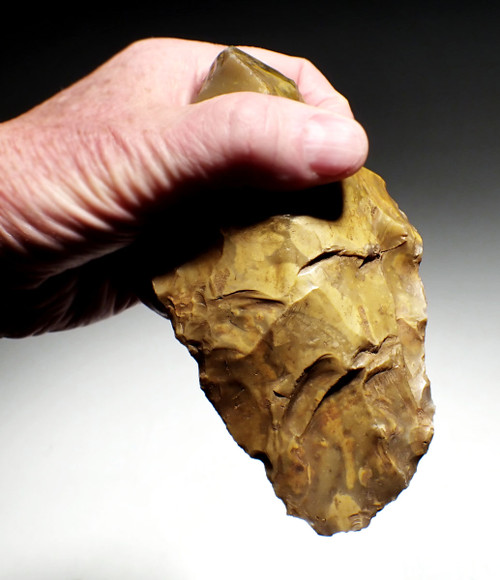Product Description
ID
|
Acheulian Tool
|
||
FOUND
|
Twydall (Kent) - England
|
||
AGE
|
ACHEULIAN: 400,000 years ago
|
||
SIZE
|
7.75" long x 3.75" wide
|
||
CONDITION
|
INTACT AND COMPLETE - NO REPAIR
|
||
NOTE
|
ULTRA RARE SPECIMEN COLLECTED
|
||
Actual Item - One Only
Comes with a certificate of authenticity / information sheet |
|||
CLICK HERE TO LEARN MORE ABOUT ACHEULIAN TOOLS
This remarkable and RARE hand axe dates from the Lower Paleolithic Period of England and was made 400,000 years ago by Homo heidelbergensis, the prehistoric humans who lived in the area at this time. This hand axe was discovered in the early 1900's and was one of a small collection of axes that were found with Clactonian flint scrapers in a famous discovery. Very few axes like this example, were found as most of the tools discovered were scrapers. Tha axe exhibits ingenious early human design in the manufacture of the grip which departed from the classic Acheulian style of the period in hand axe design. We have no other pieces from this collection other than this ULTRA-RARE example of the original collection. It is probably one of the rarest European Acheulian hand axes we could ever offer. Lower Paleolithic material from England is FAR MORE SCARCE than similar specimens from other parts of continental Europe. NO MODERN DAMAGE, NO REPAIR and NO RESTORATION. 'As found' condition.
The details on this piece and its history is as follows: The collection was originally collected by a Mr Richard Jones of Welling in Kent during the period of 1912 - 1915. Mr George Payne of the Kent Archaeological Society also collected along with a Mr George Baker.
During the year of 1902 "Sharpes Green Cement Works" was erected then the smallest cement works on record,using second hand equipment and the last to use Static Chamber Kilns. The processing site was situated on the south shore of the river Medway near Gillingham-Kent, on an island known locally as "Horrid Hill" just off the shore. Horrid Hill so named because French prisoners of the Napoleonic War who attempted to escape the "Hulks" moored on the river were hanged here for their efforts. The raw material for the manufacture of cement i.e. Chalk was extracted from a local quarry in orchard grounds belonging to a Mr Walter Stunt of Lorrendon-Faversham, Kent, a place called Twydall between Chatham and Upchurch. During the removal of the chalk a infilled cavity was broken through on the eastern face of the quarry, which contained very rich lower Palaeolithic material.
To facilitate the removal of the extracted chalk from the quarry to the works on the river a trackway was constructed to allow a small horse drawn railway to carry wagon loads of chalk for processing. To transport the loads over the tidal saltmarsh from river bank to the island a causeway was built above the upper tidal limit to the works. The material used was the gravel extracted at the quarry which was useless for the manufacture of cement of which contained the implements. The subsequent erosion caused by the tidal flow of the river exposed the Palaeolithic implements along the stretch of the causeway, which during the period of 1912 to 1915 were collected from the surface. The majority of the material is made up of Flakes and Cores typical of the "Clactonian" style with also some Acheulian axes. The implements are well retouched and worked on thick,heavey hard-hammer flakes with high angle platforms-typical of the "Clactonian" industry. The tools are made from the same marbled north kent flint which was used at the Swanscombe Palaeolithic site, the ancient lower gravels of the Thames valley. This flint is a brown and yellow banded variety derivd from the Dark green skinned nodules of the "Bull Head" bed which underlies the Thanet sands.
 US DOLLAR
US DOLLAR
 EURO
EURO
 AUSTRALIAN DOLLAR
AUSTRALIAN DOLLAR
 CANADIAN DOLLAR
CANADIAN DOLLAR
 POUND STERLING
POUND STERLING




























